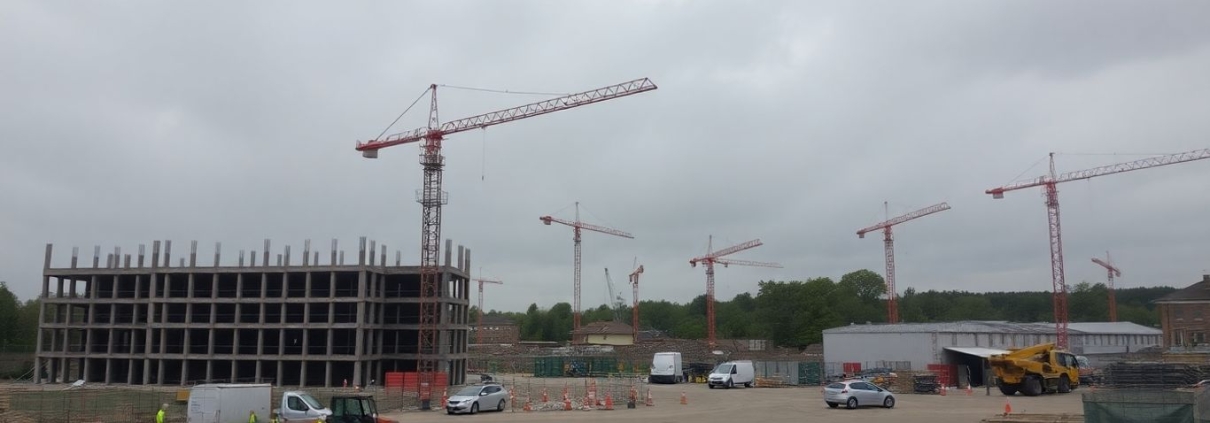UK Construction Downturn Eases As Output Declines Slow In September
The latest S&P Global UK Construction PMI shows that while the UK construction sector is still contracting, the rate of decline eased in September, reaching its slowest pace in three months. This change reflects a more moderate drop in new projects and hints that the sector’s prolonged slump may be stabilising, though significant challenges remain.
Key Takeaways
- Construction output declined for a ninth consecutive month, but the contraction in September was less severe than in previous months.
- The Construction PMI rose to 46.2 in September, up from 45.5 in August, remaining below the neutral 50.0 level.
- Civil engineering continued to be the weakest segment, while residential building saw a softer fall.
- Commercial construction was the only sub-sector to worsen, with a slightly faster rate of decline.
- Ongoing hiring freezes led to job losses for a ninth month, although some firms boosted apprentice recruitment.
- Cost pressures intensified, but input price inflation was still below the highs from earlier in the year.
- Business confidence stayed subdued, with the outlook barely changed from August’s low point.
Construction Activity Contracts But Pace Of Decline Eases
September’s Construction PMI reading of 46.2 was the highest in three months, though it still indicated contraction in the sector for the ninth month running. The less severe downturn was supported by a slower decrease in new work, particularly in housing. However, this figure remained firmly below the 50.0 threshold that separates growth from contraction, underscoring persistent market weakness.
Residential activity recorded an index of 46.8, showing a less marked fall, while civil engineering lagged behind at 42.9 despite a modest improvement. Conversely, commercial construction fared worse than in August, recording a sharper decline at 46.4.
Persistent Challenges: Low Demand And Cautious Clients
Construction companies continued to highlight a lack of new project starts and subdued demand, with order books deteriorating for a ninth consecutive month. Industry participants cited heightened economic uncertainty and client hesitancy, particularly ahead of the Autumn Budget. This has made it difficult for firms to convert potential sales into actual projects.
Though most sectors saw contracting activity, there were pockets of optimism. Some firms reported new business, especially in the energy sector, suggesting that demand for infrastructure and sustainability projects could provide some support moving forward.
Employment Trends And Cost Pressures
Employment numbers in construction have fallen each month since the start of the year, as companies responded to shrinking workloads by freezing hiring and not replacing staff departures. This trend represents the longest continuous period of job shedding since the pandemic. Notably, apprenticeship recruitment saw a marginal uptick, indicating some investment in future skills despite the gloomy near-term market.
Input costs increased at a faster rate than in August, attributed to rising wages, and higher prices for energy, raw materials, and transport. Even so, inflation remains less acute than earlier in 2025, partly due to modest improvements in supply conditions such as reduced lead times for materials.
Modest Optimism Amid Economic Uncertainty
Despite hopeful signs, business optimism within UK construction remains muted, with confidence levels staying close to record lows. The industry awaits signals of support from potential infrastructure spending, lower interest rates, and reforms to planning systems. However, caution prevails, as concerns over the economic backdrop and looming policy announcements, such as the Autumn Budget, deter major investment.
In summary, the slower decline in construction activity brings tentative relief but is not yet a clear sign of recovery. The sector still faces considerable barriers to growth, with the coming months critical in determining whether improvements can be sustained or if the downturn will persist.
References
- UK construction output falls at slowest pace for three months, Agg-Net.
- Builders’ Merchants News – UK construction output falls at slowest pace for three months, Builders’ Merchants News.
- Construction output falls at slowest pace for three months – S&P Global – The Intermediary, The Intermediary.
- UK Construction Output Falls at Slowest Pace for Three Months — TradingView News, TradingView.
- UK construction output falls at slowest pace in three months By Investing.com, Investing.com UK.



